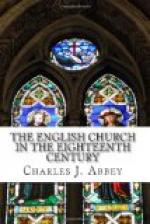[Footnote 903: Tatler, No. 264.]
[Footnote 904: Parochial Antiquities—Jeaffreson, ii. 16 (note).]
[Footnote 905: Gay’s Poems, ’The Dirge’—Anderson’s B. Poets, viii. 151.]
[Footnote 906: Burns’ Eccles. Law, i. 370.]
[Footnote 907: A few still remain, as at Rycote, in Oxfordshire.]
[Footnote 908: ’Smoothing the dog’s ears of the great bible ... in the black letter in which our bibles are printed.’—’Memoirs of a Parish Clerk,’ Pope’s Works, vii. 225.]
[Footnote 909: Walcot, 115.]
[Footnote 910: Gentleman’s Mag. vol. lxix. 667.]
[Footnote 911: Beresford Hope, Worship, &c., 68, 129.]
[Footnote 912: Secker’s Fourth Charge (1750), 154, and Fifth Charge (1753), 180.]
[Footnote 913: Pietas Londinensis, passim.]
[Footnote 914: W. Longman’s Hist. of St. Paul’s, p. 145.]
[Footnote 915: Ralph Thoresby’s Correspondence, ii. 384.]
[Footnote 916: Alex. Gilchrist’s Life of Blake, i. 41.]
[Footnote 917: Quoted, with a similar passage from Story’s Journal, by Walcot, 104.]
[Footnote 918: Ralph Thoresby’s Diary, i. 60.]
[Footnote 919: Report of Conference of 1641, upon ’Innovations in Discipline,’ quoted in Hunt’s Religious Thought in England, i. 196.]
[Footnote 920: Quoted in Beresford Hope, Worship, &c., p. 232.]
[Footnote 921: Quoted by Hunt, iii. 48, note.]
[Footnote 922: Thoresby’s Diary, i. 60.]
[Footnote 923: E. Nelson’s Life of Bishop Bull, 52.]
[Footnote 924: Quoted in a review of Surtees’ ‘Hist. Durham,’ Q. Rev. 39, 404. The charge was so persistently repeated that Archbishop Secker thought it just to his friend’s memory to publish a formal defence. He regretted, however, that the cross had been erected. It was a cross of white marble let into a black slab, and surrounded by cedar work, in the wall over the Communion Table.—T. Bartlett’s Memoirs of Bishop Butler, 91, 155.]
[Footnote 925: Guardian, No. 21, April 4, 1713.]
[Footnote 926: There were, however, some who put up pictures about the altar, and defended their use as ’the books of the vulgar.’—Life of Bishop Kennet, in an. 1716, 125.]
[Footnote 927: Lathbury’s History of the Nonjurors, 256.]
[Footnote 928: Diary of Mary Countess Cowper (1714-20), pub. 1864, 92; and Life of Bishop White Kennet, 1730, 141-2.]
[Footnote 929: A very different anecdote may be told of an altar-piece in St. John’s College, Cambridge. ‘At Chapel,’ wrote Henry Martyn, in 1800, ’my soul ascended to God: and the sight of the picture at the altar, of St. John preaching in the wilderness, animated me exceedingly to devotedness to the life of a missionary.’—Journal, &c., ed. by S. Wilberforce, quoted in Bartlett’s Memoirs of Bishop Butler, 92.]




